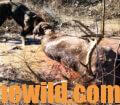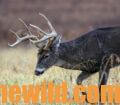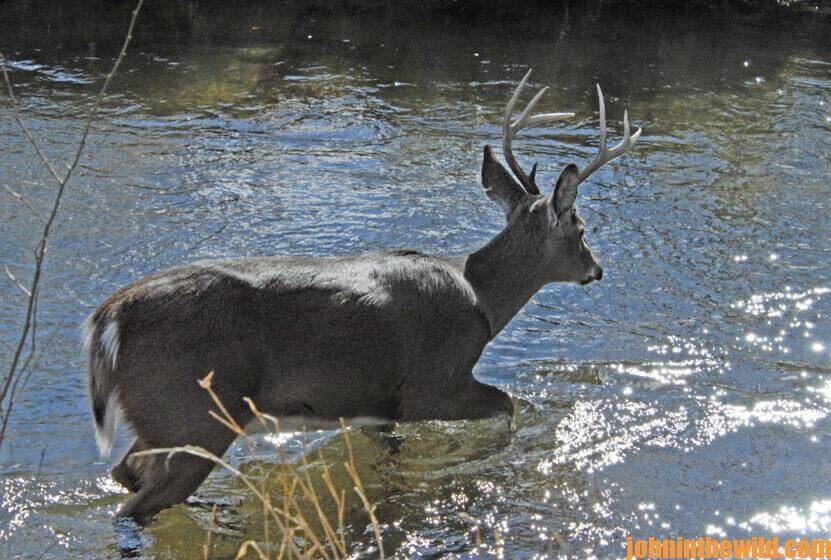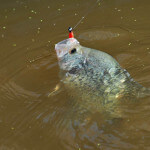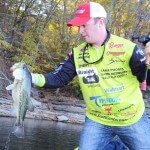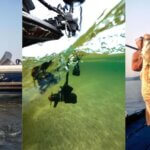Editor’s Note: In many southern states, deer season is still continuing through February, which means hunters will have to deal with the problem of recovering wounded deer. A growing number of hunters in each state are training tracking and trailing dogs to find and recover wounded deer. More states are opening their doors to allow hunters to use tracking dogs – even sometimes on public lands. Who are these folks? Why are they buying and/or teaching dogs to become tracking dogs? What tools are they using to teach keen-nosed dogs to find deer when the blood trail has run out? If you live in a state where hunters are permitted to use tracking and trailing dogs, you may want to consider getting a young dog now and training him to track deer for next year’s deer season. (Be sure to check your state’s regulations). I met Patrick Jones of McCalla, Alabama, who’s in the construction business at the Department of Conservation’s Adult Mentoring program for bowhunting deer. Jones told me about how a tracking and trailing dog could make a huge difference in your enjoying deer hunting.
 Some years ago I went on a hunt on Giles Island, an island in the middle of the Mississippi River on the Louisiana/Mississippi border. The people there raise and train tracking dogs. The head dog trainer allowed me to go with him at first light with his dog to try to find a buck that had been shot late the afternoon before. There’d been a hard rain all night long, and the rain just had stopped right before we left camp to attempt to pinpoint this wounded deer. In my mind, I was thinking, “There’s no way this dog will be able to find any blood or be able to locate this deer.”
Some years ago I went on a hunt on Giles Island, an island in the middle of the Mississippi River on the Louisiana/Mississippi border. The people there raise and train tracking dogs. The head dog trainer allowed me to go with him at first light with his dog to try to find a buck that had been shot late the afternoon before. There’d been a hard rain all night long, and the rain just had stopped right before we left camp to attempt to pinpoint this wounded deer. In my mind, I was thinking, “There’s no way this dog will be able to find any blood or be able to locate this deer.”
We went to the stand site where the man had shot his buck. The dog made a circle of the area and then took off running. I asked, “Don’t we need to follow that dog?” The trainer answered, “No, when the dog locates the deer, he’ll let us know.” Within 15 minutes, sure enough, the dog discovered the man’s buck in a place where we never would have looked for him. When I asked how that dog was able to find that deer, although the blood trail had to have been washed away by the pouring rain, he said, “To be honest, I don’t really know. I think there’s some kind of scent that a wounded deer gives-off that the dog can smell, regardless of weather conditions.”
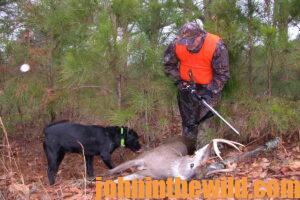 That dog trainer then told me a story that was hard for me to believe. “I took my dog out late one afternoon and put him on a trail of a buck that had been shot. As light failed, I started following my dog. He ran through some tall grass and spooked about eight to 10 deer – both bucks and does – that were bedded-down in that grass. But my dog didn’t veer off the track of the wounded deer. He went right through that covey of deer. About 300-400 yards past where the deer had been bedded-down, he discovered the hunter’s buck.”
That dog trainer then told me a story that was hard for me to believe. “I took my dog out late one afternoon and put him on a trail of a buck that had been shot. As light failed, I started following my dog. He ran through some tall grass and spooked about eight to 10 deer – both bucks and does – that were bedded-down in that grass. But my dog didn’t veer off the track of the wounded deer. He went right through that covey of deer. About 300-400 yards past where the deer had been bedded-down, he discovered the hunter’s buck.”

How does a dog learn to stay on a wounded deer when there’s no visible sign of any blood on the ground? I’ve been on several other hunts where tracking dogs were used to find deer that would have been lost except for the keen nose of a well-trained tracking and trailing dog. I learned the answer to that question when I went to a “Learn to Deer Hunt with a Bow” one-day seminar conducted by Alabama’s Game and Fish Division for people interested in learning how to bowhunt (https://www.outdooralabama.com/hunting/adult-mentored-hunting-program). That’s where I met Joseph Dunn and Patrick Jones, both of McCalla, Ala., who had brought their tracking dogs to show these newbie bowhunters how a tracking dog could help them find their deer – even if the hunters have given-up all hopes of recovering their whitetails.
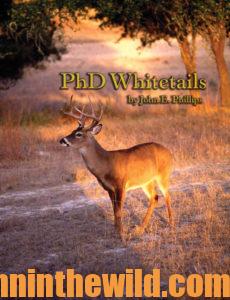 To learn more about hunting for deer, check out John E. Phillips’ deer-hunting book, “PhD Whitetails: How to Hunt and Take the Smartest Deer on Any Property,” available in Kindle and print at http://amzn.to/WIEUoo and Audible at https://www.audible.com/. For more information about hunting for deer, check out John E. Phillips’ “Jim Crumley’s Secrets of Bowhunting Deer,” now available as of January 1, 2022, in Audible, as well as paperback and Kindle at https://www.amazon.com/. You may have to copy and paste these links into your browser. (When you click on either book, notice on the left where Amazon says you can read 10% of this book for free and hear 10% for free). On the right side of the page and below the offer for a free Audible trial, you can click on Buy the Audible book. To see many of John E. Phillips’ books, go to https://www.amazon.com/John-E.-Phillips/e/B001HP7K6O.
To learn more about hunting for deer, check out John E. Phillips’ deer-hunting book, “PhD Whitetails: How to Hunt and Take the Smartest Deer on Any Property,” available in Kindle and print at http://amzn.to/WIEUoo and Audible at https://www.audible.com/. For more information about hunting for deer, check out John E. Phillips’ “Jim Crumley’s Secrets of Bowhunting Deer,” now available as of January 1, 2022, in Audible, as well as paperback and Kindle at https://www.amazon.com/. You may have to copy and paste these links into your browser. (When you click on either book, notice on the left where Amazon says you can read 10% of this book for free and hear 10% for free). On the right side of the page and below the offer for a free Audible trial, you can click on Buy the Audible book. To see many of John E. Phillips’ books, go to https://www.amazon.com/John-E.-Phillips/e/B001HP7K6O.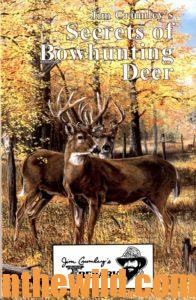
Tomorrow: Patrick Jones’ Tracking Dogs’ Wounded Deer Adventures

